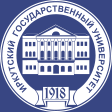List of issues > Series «Earth Sciences». 2025. Vol 51
Regional Features of the Modern Climatic Period in the
Irkutsk Region
Latysheva Inna Valentinovna, Candidate of Sciences (Geography), Head, Department of Meteorology and Physics of Near-Earth Space, Irkutsk State University, 1, K. Marx st., Irkutsk, 664003, Russian Federation, e-mail: ababab1967@mail.ru
Loshchenko Kristina Anatolievna, Candidate of Sciences (Geography), Associate Professor of the Department of Meteorology and Physics of Near-Earth Space, Irkutsk State University, 1, K. Marx st., Irkutsk, 664003, Russian Federation, e-mail: loshchenko@bk.ru
Vologzhina Sayana Zhamsaranovna, Candidate of Sciences (Geography), Dean, Geographical Faculty, Associate Professor of the Department of Hydrology and Nature Management, Irkutsk State University, 1, K. Marx st., Irkutsk, 664003, Russian Federation, e-mail: svologzhina@gmail.com
Gekova Anastasia Vasilievna, Student, Geographical Faculty, Irkutsk State University, 1, K. Marx st., Irkutsk, 664003, Russian Federation, e-mail: gekova00@bk.ru
Alekseev D.K., Primak E.A., Kanukhina A.Yu. et al. Dinamika zelenykh nasazhdenii v SanktPeterburge i klimaticheskie riski [Dynamics of green spaces in St. Petersburg and climate risks]. Uspekhi sovremennogo estestvoznaniya [Achievements of modern natural science], 2024, no. 8, рр. 6- 11. (in Russian)
Ivanov S.P. Energetika i klimaticheskie riski [Energy and climate risks]. Vestnik energetiki [Energy Bulletin], 2022, no. 6, рр. 30-55. (in Russian)
Klimov N.A. Klimaticheskie izmeneniya i prodovolstvennaya bezopasnost [Climate change and food security]. Sel'skoe khozyaistvo i ekonomika [Agriculture and Economics], 2022, no. 5, рр. 22-40. (in Russian)
Semenova E.I., Soroka A.O., Nedbaev I.S. Prostranstvennaya differentsiatsiya lesov sub"ektov Rossiiskoi Federatsii na osnove avtorskoi metodiki otsenki urovnya adaptatsii k izmeneniyam klimat [Spatial differentiation of forests of the subjects of the Russian Federation based on the author's methodology for assessing the level of adaptation to climate change]. Lesotekhnicheskii zhurnal [Forestry journal], 2024. vol. 14, no. 1 (53), рр. 16-34. (in Russian)
Sinyukovich V.N., Latysheva I.V., Makukhin V.L. Klimaticheskie riski dozhdevykh pavodkov na pritokakh Yuzhnogo Baik [Climate risks of rain floods on the tributaries of Southern Baikal] Klimaticheskie riski i kosmicheskaya pogoda [Climate risks and space weather]. Proceedings of the International Conference dedicated to the memory of Nina Konstantinovna Kononova]. Irkutsk, 2021, рр. 207-214. (in Russian)
Soldatenko S.A. Klimaticheskie riski osvoeniya rossiiskoi Arktiki [Climate risks of development of the Russian Arctic]. Enviromis 2024 [In the collection: Enviromis 2024]. Collection of scientific papers of the International Conference on Measurements, Modeling and Information Systems for Environmental Studies. Tomsk, 2024, рр. 186-192. (in Russian)
Tretii otsenochnyi doklad ob izmeneniyakh klimata i ikh posledstviyakh na territorii Rossiiskoi Federatsii. Obshchee rezyume [The Third Assessment Report on Climate Change and its Consequences in the Russian Federation]. Obshchee rezyume. St. Petersburg, Science-intensive technologies Publ., 2022, 124 p. (in Russian)
Tsyganov V.V., Savushkin S.A., Lemeshkova A.V. Klimaticheskie riski zheleznodorozhnoi infrastruktury [Climate risks of railway infrastructure]. Informatsionnye tekhnologii v nauke, obrazovanii i upravlenii ITNOU [Information technologies in science, education and management], 2024, vol. 1-2, (22-23), pp. 8-13. (in Russian)
Brown P.H., Tullos D., Tilt B. et al. Modeling the costs and benefits of dam construction from a multidisciplinary perspective. J. Environ. Manage, 2009, vol. 90 (SUPPL. 3), pp. S303-S311. http://doi.org/10.1016/j.jenvman.2008.07.025
Karlson C.W., Morsut C., Engen H.The politics of local climate risk management – A comparison of risk logic in the Netherlands, Norway, and Sweden. Climate Risk Management, 2024, vol. 45, pp. 100626. http://doi.org/10.1016/j.crm.2024.100626
Tilman D., Clark M. Global diets link environmental sustainability and human health. Nature, 2012, vol. 515, pp. 5180522. http:// doi.org/10.1038/nature13959
Kjellstrom T., Lemke B., Otto M. Mapping occupational heat exposure and effects in SouthEast Asia: Оngoing time trends 1980–2011 and future estimates to 2050. Ind Health, 2013, vol. 51, pp. 56-67. http://doi.org/10.2486/indhealth.2012-0174
Murray-Tortarolo G.N., Salgado M.M. Drought as a driver of Mexico-US migration. Clim. Change, 2021, Vol. 164, pp. 48. https://doi.org/10.1007/s10584-021-03030-2
Nawrotzki R.J., DeWaard, Bakhtsiyarava J.М. et al. Climate shocks and rural-urban migration in Mexico: exploring nonlinearities and thresholds. Clim. Change, 2017, vol. 140, no. 2, pp. 243–258. https:// doi.org/10.1007/s10584-016-1849-0
Shah M.A.R., Rahman A., Chowdhury S.H. Challenges for achieving sustainable flood risk management. J. Flood Risk Manage, 2015, vol. 11, no. S1, pp. S352-S358. https://doi.org/10.1111/jfr3.12211.
Shariatzadeh M., Bijani M., Abbasi E. et al. An adaptation capacity model in the face of climate change: A qualitative content analysis. Journal of Arid Environments, 2021, vol. 185, pp. 104326. https://doi 10.1016/j.jaridenv.2020.104326
Honert R.C., Mcaneney J. The 2011 Brisbane Floods: Causes, Impacts and Implications. Water, 2011, vol. 3, no. 4, pp. 1149-1173. https:// doi.org/10.3390/W3041149
Vicedo-Cabrera A.M., Scovronick N., Sera F. et al. The burden of heat-related mortality attributable to recent human-induced climate change. Nature Climate Change, 2021, vol. 11, no. 6, pp. 492. https://doi.org/10.1038/s41558-021-01058-x
